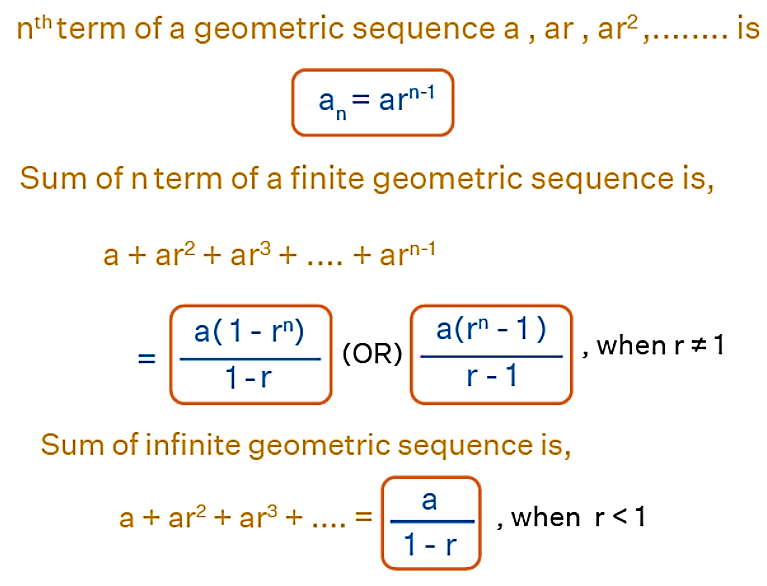
The concept of a geometric series formula . This is a sequence of terms where the ratio between any two consecutive terms remains constant. The geometric series formula encompasses three key aspects:
- Determining the nth term of a geometric series formula.
- Calculating the sum of a finite geometric series formula.
- Computing the sum of an infinite geometric series formula.
What is a Geometric Series Formula?
A geometric series represents the summation of a finite or an infinite number of terms from a geometric sequence. In a geometric sequence, such as a, ar, ar^2, ..., ar^n-1, the corresponding geometric series is formed by adding these terms: a + ar + ar^2 + ... + ar^n-1 + .... Remember that "series" signifies "sum." In this context, a geometric series entails the addition of terms that maintain a constant ratio between consecutive elements. Geometric series can be of two types: finite and infinite. Here are some examples to illustrate this:
1/2 + 1/4 + .... + 1/8192 is an example of a finite geometric series, with the initial term a = 1/2 and a common ratio r = 1/2. -4 + 2 - 1 + 1/2 - 1/4 + ... exemplifies an infinite geometric series, where the first term is a = -4, and the common ratio is r = -1/2.
Geometric Series Meaning
The geometric series formula encompasses calculations for the sum of a finite geometric sequence, the sum of an infinite geometric series, and the nth term of a geometric sequence. This sequence takes the shape of {a, ar, ar^2, ar^3, ...}, where 'a' represents the initial term, and 'r' signifies the constant ratio between consecutive elements. The formulas for a geometric series cover three essential aspects: finding the nth term, calculating the sum of a finite series, and determining the sum of an infinite series. Let's consider a geometric series with a first term 'a' and a common ratio 'r.'
The formulas for a geometric series cover three essential aspects: finding the nth term, calculating the sum of a finite series, and determining the sum of an infinite series. Let's consider a geometric series with a first term 'a' and a common ratio 'r.'
Formula 1: To find the nth term of this geometric sequence, use
nth term = a * r^(n-1) Where:'a' is the initial term 'r' is the common ratio between consecutive terms 'n' is the term number.Formula 2: For the sum of a finite geometric series a + ar + ar^2 + ar^3 + ... + ar^(n-1), the formula is
Sum of n terms = a * (1 - r^n) / (1 - r) (or) a * (r^n - 1) / (r - 1)Where:'a' is the first term 'r' is the common ratio between consecutive terms 'n' is the number of terms.Formula 3: To calculate the sum of an infinite geometric series a + ar + ar^2 + ar^3 + ..., you can use
Sum of infinite geometric series = a / (1 - r) Where: 'a' is the initial term 'r' is the common ratio between consecutive terms.Convergence of Geometric Series Formula
A finite geometric series always converges. However, the convergence of an infinite geometric series is contingent on the value of its common ratio. An infinite geometric series, denoted as a, ar, ar², and so on, converges when the absolute value of the common ratio, |r|, is less than 1. In such cases, we can determine its sum using the formula a / (1 - r). On the other hand, it diverges when |r| exceeds 1, and as a result, we cannot compute its sum. For example: The geometric series 2 + 4 + 8 + 16 + ... diverges because |r| = |2| = 2, which is greater than 1. Consequently, its sum cannot be determined. In contrast, the geometric series 1 - 1/2 + 1/4 - 1/8 + 1/16 - ... converges as |r| = |-1/2| = 1/2, which is less than 1. Therefore, its sum is calculated as a / (1 - r) = 1 / (1 - (-1/2)) = 1 / (3/2) =2/3Geometric Series Formula applications
The formula for the sum of a geometric series can be applied in various real-world situations where quantities grow or decrease by a fixed ratio. Here are a few examples of how the geometric series formula can be applied:-
Financial Investments:
- When calculating the future value of an investment or savings account with a fixed interest rate, the formula can be used. For example, the formula can be applied to determine the total amount in a bank account after a certain number of years with annual compounding.
-
Population Growth:
- In the context of population studies, the formula can be used to model population growth where the population size increases or decreases by a fixed percentage each year. This is especially relevant in ecological studies and the analysis of demographic data.
-
Radioactive Decay:
- The formula is used in nuclear physics to model the rate of radioactive decay of a substance. Radioactive isotopes decay exponentially, and the formula can be used to calculate the remaining amount of the isotope at any given time.
-
Computer Algorithms:
- In computer science, the formula can be used to analyze the time complexity of algorithms that exhibit geometric behavior. Algorithms with constant factors or geometric progressions are often analyzed using this formula.
-
Marketing and Sales:
- When studying customer acquisition or attrition, businesses can use the formula to model customer retention rates. It's also applicable in scenarios where products experience exponential growth in sales due to viral marketing or word-of-mouth.
-
Loan Amortization:
- The formula can be applied in loan amortization schedules, especially for loans with fixed interest rates. It helps in calculating monthly payments and understanding how much of each payment goes towards interest and principal.
-
Exponential Growth and Decay:
- Geometric series can be used to understand exponential growth and decay in various fields, such as biology, physics, and engineering. It helps in modeling and predicting the behavior of systems where quantities change exponentially.
| Related Links | |
| Fibonacci Sequence Formula | Eulers Formula |
| Exponential Formula | Factorial Formula |
Geometric Series Formula
What is a geometric series?
How can you determine if a geometric series converges or diverges?
What's the formula for finding the sum of an infinite geometric series?
Can you find the sum of a finite geometric series?
Can a geometric series have a negative common ratio?










